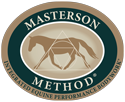Can I do this Wrong?
We use techniques with this method that use no pressure or movement, and some that involve different levels of pressure and movement. But they all rely on reading the responses of the horse, and softening when we run into resistance. If you’re doing this then 1) you can’t hurt the horse, and 2) you can’t do it wrong. The more you do it the better you get at reading the horse and softening; so you can always do it better, but it’s pretty hard to do it wrong.
So how does this method work?
It works using the horse’s natural survival instincts, and his body language.
The first part is that the horse is a survival animal. His first survival instinct is to flee from any sense of danger, pressure, or discomfort. His second survival instinct, when he doesn’t have the option of fleeing, is to push against or brace either internally or externally against danger, pressure or discomfort.
The second part of this is that the horse communicates primarily through body language. His verbal vocabulary is very limited, a few whinnies here, and a nicker or a neigh there. But his body language ranges from the very subtle, such as a change in breathing or a twitching of the eye, to the more obvious, such as pinning the ears, threatening to kick, or even kicking. If the horse shows even subtitle signs of lameness or weakness in the wild then he’ll be the first one picked off by the predator or pushed out by the herd. So, his nervous system is programmed to block out pain and keep on going.
When we humans start to feel pain, we let everyone know about it, and then if we’re smart, we do something about it. But the horse has no option but to cover it up and keep on going
With this method, we learn how to stay under the horse’s survival bracing response and read what the horse’s body language is telling us. When we do this, we can not only find where the horse is blocking tension or holding onto tension, but we can get the horses body to begin the process of letting go of that tension. By using levels of touch and movement that stay under the bracing response, we bring the horse’s awareness to tension that he’s been blocking out in a way that he can’t brace against it.
We access that part of the horse’s nervous system that releases rather than holds onto tension. We work with the horse’s natural instincts, rather than against them. And the horse works with us, rather than against us.
How Does This Build Trust with the Horse?
Once you learn how to read the body language of the horse then you and the horse are on the same page, and communication is established.
When you learn how to use that body language to get the horse to release tension, trust with the horse is developed and relationship is established. A bond is formed. The horse realizes that you recognize his language and that there is no threat, and that he’s feeling better.
